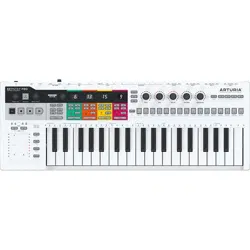Loading ...
Loading ...
Loading ...

5.5.1.3. User Scales
From the Arturia factory, the KeyStep Pro comes complete with six predefined scales, but
you can create your own custom scales and store them as User 1 or User 2.
In the example below, we'll add Bhairavi, a well-known and popular scale in Indian music.
Bhairavi has lowered second, third, sixth and seventh steps. So, based on C, it plays as C,
Db, Eb, F, G, Ab, Bb (C').
To create this scale, we have to eliminate notes that are not part of it. This is how you do it:
Hold down 'Shift' and press Scale>User 1 (F# in the upper octave of the keyboard)
Now focus on the 12 keys in the lower octave of the keyboard. The LEDs above all those keys
have lit up, meaning that all keys will play. We need to change this so that only the keys of
the Bhairavi scale will play. Therefore, we have to eliminate D, E, F#, A and B. Press those
keys to deactivate them.
By setting a new Root for the scale, you make the series of intervals start at a new position
on the keyboard. The intervals of Bhairavi are: 1/2, 1, 1, 1, 1/2, 1 or s-T-T-T-s-T.
If we set the root of Bhairavi to Db (which is, in fact, how it is often played on Indian
harmoniums, sitars, sarods, etc.) the scale will be transposed to Db, D, E, F#, G#, A, B (Db').
♪: If you haven't yet made any changes to the User 1 and User 2 scales, they will both be chromatic.
5.5.2. Chord Mode
The KeyStep Pro can memorize a chord. You can then play that chord just by pressing a
single key on the keyboard. The chord will automatically transpose as you press different
keys.
Initiate Chord mode by holding 'Shift' + Chord and press the notes you want to add to the
chord. You can now let go of the 'Shift' + Chord buttons. As long as you keep one note down
you can continue to add notes to the chord.
Chord mode lets you experiment with chord transpositions in new ways. It's a unique new
KeyStep Pro feature. Initiate Chord mode by holding down 'Shift' then pressing the Tie/Rest/
Chord button. Now, as soon as you play a chord of up to sixteen notes on the keyboard, the
KeyStep Pro will remember its interval structure and allow you to play it with just one key. It
will also intelligently take the current Root note into account and adapt to the current Scale.
Chords are derived from scales. The most common three-note chords consist of the first,
the third and the fifth of a scale. The most common four-note chords consist of the first, the
third, the fifth and the seventh of a scale. The first note of a chord is the Root. The third note
in a scale determines the 'feel' of a chord: if it is three semitones above the Root, the chord is
minor; if it is four semitones above the Root, the chord is major. When you add more notes
to a chord, you are essentially fine-tuning or further shaping the minor or major feel.
When you initiate Chord mode and play some notes on the keyboard, the KeyStep Pro will
analyse the interval structure of the chord you play. When next you play a single note on
the keyboard, it will reconstruct that interval structure based on the note you play. If it was
a minor seventh chord (for example, Cmin7), it will create a minor seventh chord based on
the key you press.
It's a feature that gives new meaning to the word 'arpeggio'. Chord mode enables you to
create blindingly fast and intricate polyphonic scale-quantized arpeggios.
Arturia - User Manual Keystep Pro - Making Tracks 111
Loading ...
Loading ...
Loading ...
